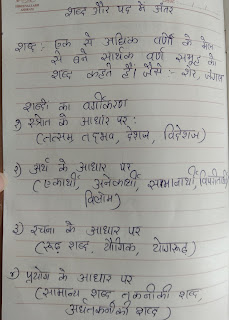IX- A Science Chapter-Motion
Distance & Displacement
Let’s take an example to understand Distance
- Consider a boy going to school, then from school going to a market, then going to a friend’s place to return his book and then coming back home let’s say he travels 2km from home to school then 1 km to market then 1 km to friends place then 2 km to reach home. Then the total path travelled by boy is 2+1+1+2=6 km. So, the sum total of path he travels in any direction gives us the distance.
Distance
It can be defined as total path covered by body in any direction. It is a scalar quantity.
- Formula: distance = total path travelled
- Unit - meter/second
- Bigger unit: Km/hour
- 1 km = 1000m
Characteristics of distance
- It can never be zero: it is not possible that body moves but the distance is zero
- If a body travels different paths then total distance is calculated by simply adding the magnitude of all the paths
- It is a scalar quantity
Let us understand displacement now
Let’s say there were 3 friends Ram, Shyam and Geeta. Now ram has to go to Geeta’s place but he doesn’t know the house so what he plans He first went to Shyam place and then with shyam he went to Geeta’s home. In doing so he has to travel long distance first to Shyam house and then to Geeta. But if he knew the house of Geeta then he would have taken a short route and in specific direction that short route in particular direction is called displacement.
Displacement
- It is the shortest route travelled by body in given direction
- It is represented as S
- It is a vector quantity
- It can be zero: whenever a body starts from one point and returns to the same point the displacement is zero.
Rest and motion
For this let us take different examples to understand it:
Let us consider a car standing in front of house. Let’s say first it is at position A then after some it moves to position B. That means it has changed its position with respect to stationary object that is house.

And if that car keeps on standing at position A that means it hasn’t changed its position with respect to house that means it is at rest so here we define the terms rest and motion.
Rest
When a body doesn’t change its position with respect to its surroundings or reference point
Motion
When the body changes its position with respect to its surroundings or reference point.
So, we can say that when any object is moving or in motion it possess following characteristics as given below.
Characteristics of moving object
- The moving object changes its position with time
Now we have seen that motion of car can be easily seen that is we don’t have to concentrate much but to know the movement of arm of clock let’s say hour hand we need to keep check this is because some motion is that fast that we can see it happening, on the other hand some motion is so slow that it can’t be seen clearly.
We can elaborate it as: Our wrist watch has three hands: minute, seconds and hour hand .out of them second hand moves fast that its motion can be seen but in order to see the motion in hour hand and minute hand we have to keep the track as the motion in them is comparatively slow.
Types of Motion
We come across different types of motions like
- Linear
- Rotational
- Circular
- Vibratory
Let us explain them with examples:
Linear
- We all when drive on road mostly the roads are straight so, that motion where we move in a straight line is called linear motion
Rotational
- You all know the earth rotates on its axis which causes day and night that movement is rotational motion because it is rotating on its axis so, we can define as the rotational motion when the body rotates about a fixed axis.
Circular
- You all encounter round bouts on road and when you are driving you can’t drive straight through it, you have to take the curved path that is the circular motion. So, if body travels along a curved path
Vibratory
- You all must have played with the instrument guitar. So, what happens when you strike it with your finger its string starts vibrating and thus the sound is produced. That motion is vibratory as it is caused due to vibratory motion of particles so it is when body show to and from movements.
Scalar and vector physical quantities
We study so many physical quantities like distance, velocity and many more. All these quantities are broadly classified under two categories that is scalar or vector depending upon where they give the complete information about the magnitude (value) and direction or give the incomplete information like only direction or only value.
Scalar Quantities
The quantities that depend upon magnitude and not the direction is called scalar quantities. They are represented as their own symbol.
For Example: If you travel to Delhi to your relative’s place and if someone asks you about the distance what do you reply. We say it was like 250km run from Chandigarh. You don’t tell him that 25km towards east, then west. We just say 250km that means we describe it only in magnitude and we don’t specify directions. So, it is a scalar quantity.
Vector Quantities
The physical quantities that depends upon magnitude as well as direction. They are represented by putting arrow on their symbol.
For Example: Now if you travel a straight short path in a specific direction then we can say that I travelled 25km towards east. So, in this case direction is specified so it falls in the category of vector quantity.
Distance & Displacement
Let’s take an example to understand Distance
- Consider a boy going to school, then from school going to a market, then going to a friend’s place to return his book and then coming back home let’s say he travels 2km from home to school then 1 km to market then 1 km to friends place then 2 km to reach home. Then the total path travelled by boy is 2+1+1+2=6 km. So, the sum total of path he travels in any direction gives us the distance.
Distance
It can be defined as total path covered by body in any direction. It is a scalar quantity.
- Formula: distance = total path travelled
- Unit - meter/second
- Bigger unit: Km/hour
- 1 km = 1000m
Characteristics of distance
- It can never be zero: it is not possible that body moves but the distance is zero
- If a body travels different paths then total distance is calculated by simply adding the magnitude of all the paths
- It is a scalar quantity
Let us understand displacement now
Let’s say there were 3 friends Ram, Shyam and Geeta. Now ram has to go to Geeta’s place but he doesn’t know the house so what he plans He first went to Shyam place and then with shyam he went to Geeta’s home. In doing so he has to travel long distance first to Shyam house and then to Geeta. But if he knew the house of Geeta then he would have taken a short route and in specific direction that short route in particular direction is called displacement.
Displacement
- It is the shortest route travelled by body in given direction
- It is represented as S
- It is a vector quantity
- It can be zero: whenever a body starts from one point and returns to the same point the displacement is zero.
- If body travels different paths then total displacement is calculated by adding different vectors
Homework - Exercise questions 1 and 2
Date- 19 /7/21
Chapter - Motion
Content taught-
Let us do a problem on distance and displacement
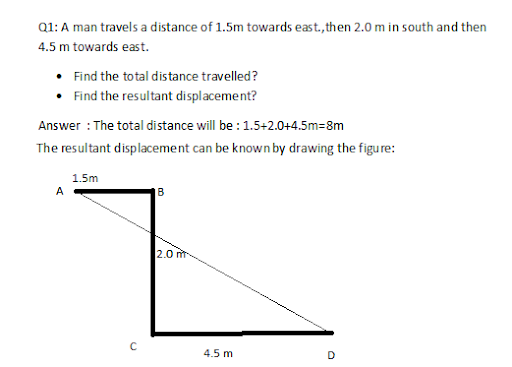

Uniform and non uniform motion
Uniform motion
When body covers equal distances in equal intervals of time, the body is said to home uniform motion.
Example: A train running at a speed of 90 km/hr.
Let’s say a train is travelling to Delhi and it covers the same distance in the same intervals of time like:
| Distance | 90 km | 180km | 270km | 450km |
Time | 1 hr | 2hr | 3hr | 4 hr |
So here we see that train travels equal distance of 90km in each hour .so it is said to be moving with uniform motion.
The graph involved in it is given as:

Non-uniform motion
When body covers unequal distance is equal intervals of time.
Example: when brakes are applied to speeding car.
Let’s say A car travelling to Delhi covers 40km in one hour and then due to huge traffic on road travels 25km in another hour and then in another hour takes a break for having lunch, then speed up the car and travels 50km in another hour. It can be shown as:
Distance | 40km | 65km | 115km |
Time | 1hr | 2hr | 3hr |
So, in this unequal distance is travelled in equal intervals of time.
The graph drawn to show non uniform motion is:

Date-22/7/21
Chapter- Motion
Content taught- Let’s do problems based on average speed
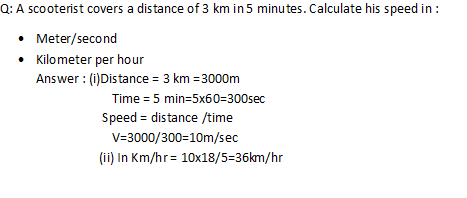

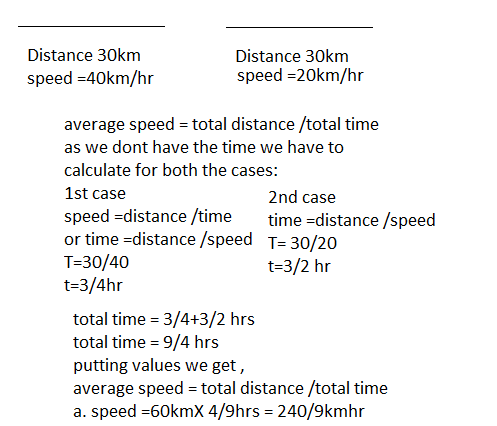

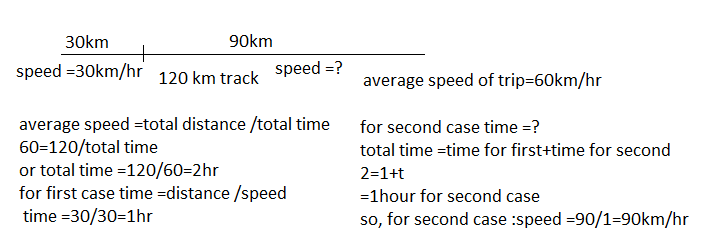
Average velocity
It is actually an arithmetic mean of initial velocity & final Velocity for given time. Or it can be defined as total displacement per unit total time taken.
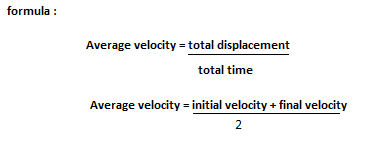
Acceleration
Whenever the velocity increases or decreases with time, then another quantity comes in to notice and that is acceleration.
Is defined as the rate of change of velocity with time.
- Units = m/sec 2 or m sec -2
- It is a vector quantity
Please Note:
- If velocity increases with time => +ve Acceleration
- If velocity decreases with time => - Acceleration or retardation ode-acceleration
Types of acceleration
- Uniform acceleration
- Non uniform acceleration
- Retardation
Velocity Time -Graph
Like we took so many examples above so, in any example if we plot velocity versus time, then we get the important information from it.
- It represents acceleration
- The area enclosed under graph gives displacement
When v-t graph is || to time axis
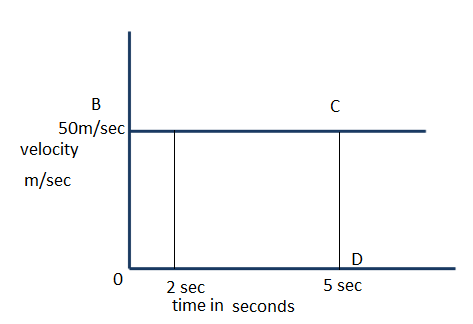
In this body is not changing its velocity with respect to time that shows body is moving with the same velocity. Like if we take the markings on the axis, we see that in any time the velocity is exactly the same.
So, the information that we get, is:
- The body is moving with constant velocity
- Acceleration = change in velocity/time
=0/5-2=0m/sec2
- The displacement =area under v-t graph
S= area of rectangle
= OBCD
= L x B= 50 x 5 = 250m
- This shows body is starting from rest & then its velocity increases at uniform rate.
When v-t is straight line
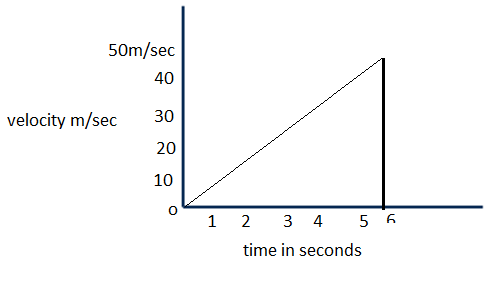
This shows velocity is directly proportional to time that shows body is moving with [uniform velocity]

